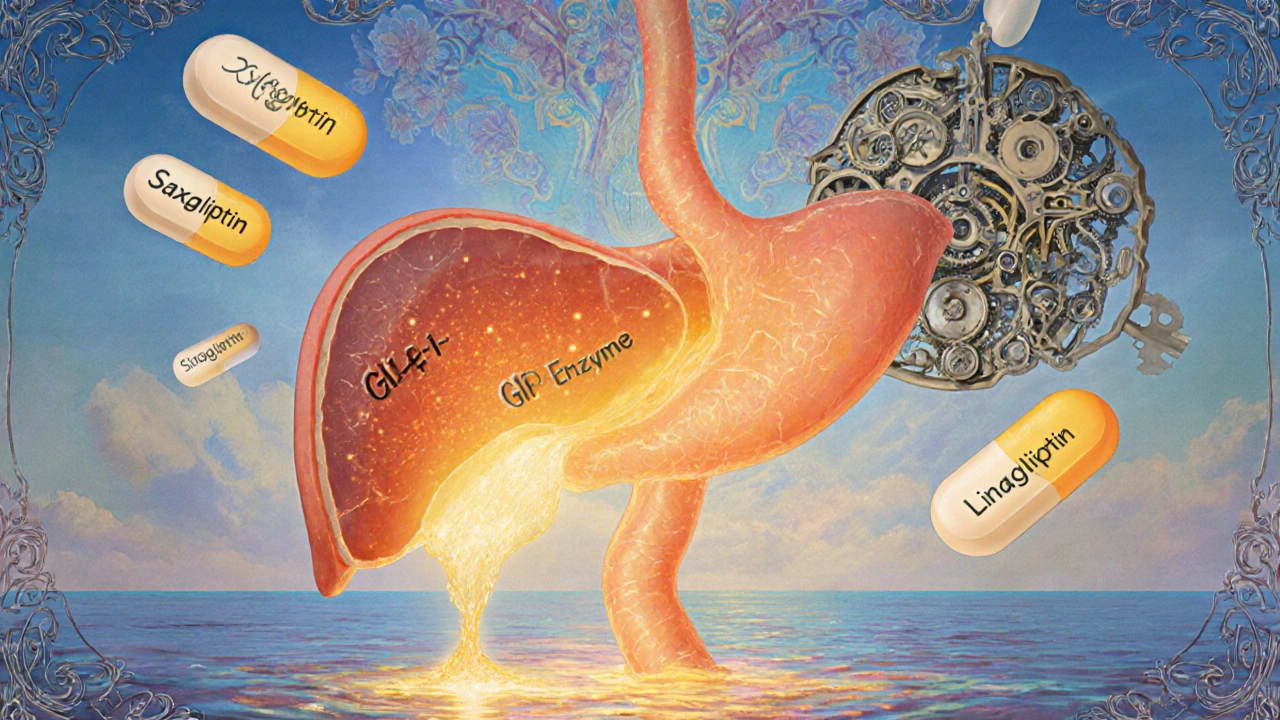Pancreatitis Risk Calculator for DPP-4 Inhibitors
This tool estimates your risk of developing pancreatitis while taking DPP-4 inhibitors based on your medical history. The absolute risk is low for most patients, but certain factors can increase your risk.
Important: This is an estimation tool only. Always consult with your doctor about your individual risk factors and medication choices.
Your Risk Factors
When you’re managing type 2 diabetes, finding a medication that lowers blood sugar without causing weight gain or low blood sugar is a big win. That’s why DPP-4 inhibitors - also called gliptins - became so popular. Drugs like sitagliptin (Januvia), saxagliptin (Onglyza), and linagliptin (Tradjenta) are easy to take, don’t cause hypoglycemia, and don’t make you gain weight. But behind the convenience is a quiet, serious risk: pancreatitis.
What Are DPP-4 Inhibitors and How Do They Work?
DPP-4 inhibitors work by blocking an enzyme called dipeptidyl peptidase-4. This enzyme normally breaks down two natural hormones - GLP-1 and GIP - that help your body release insulin after meals and reduce the liver’s sugar production. By keeping these hormones active longer, DPP-4 inhibitors help lower blood sugar without forcing your pancreas to overwork.
They were first approved in 2006 with sitagliptin. Since then, four others joined the list: saxagliptin, linagliptin, alogliptin, and vildagliptin (not available in the U.S.). These drugs are taken as pills, once a day, and are often combined with metformin. They’re not for type 1 diabetes or diabetic ketoacidosis. But for many people with type 2 diabetes, they’re a solid option - especially if you’re worried about low blood sugar or weight gain.
Pancreatitis: The Real, But Rare, Danger
Pancreatitis means your pancreas is inflamed. It can be mild or life-threatening. Symptoms include severe, constant pain in your upper belly that may spread to your back, nausea, vomiting, and fever. If you’ve ever had gallstones or drink heavily, you already know how bad this can be.
Studies show DPP-4 inhibitors slightly raise the risk. A 2024 analysis of over 53,000 patients found a 54% higher chance of acute pancreatitis compared to other treatments. Another study using real-world data from 1.2 million people found that for every 1,000 patients on these drugs for two years, there were 1 to 2 extra cases of pancreatitis.
That sounds scary - but let’s put it in perspective. The baseline risk of pancreatitis in people with diabetes is already higher than in people without diabetes. So even with the added risk, the absolute chance is still very low. The FDA and European Medicines Agency agree: the risk is real, but rare.
What’s more, most cases go away when you stop the drug. According to the UK’s Medicines and Healthcare products Regulatory Agency (MHRA), about 82% of pancreatitis cases linked to DPP-4 inhibitors resolved after discontinuation.
How Do We Know This Risk Is Real?
Early clinical trials didn’t catch much because pancreatitis is uncommon - only a few cases showed up in studies with thousands of patients. The real signal came after the drugs were on the market. Doctors started reporting cases through the FDA’s Adverse Event Reporting System and the UK’s Yellow Card scheme. That’s when patterns emerged.
Large cardiovascular outcome trials - meant to test heart safety - accidentally revealed the pancreatitis link. In trials for saxagliptin, alogliptin, and sitagliptin, more patients on the drug developed pancreatitis than those on placebo. The numbers were small, but consistent enough to trigger regulatory action.
In 2013, the FDA and EMA both updated drug labels to warn about pancreatitis. The MHRA confirmed it in 2012. Since then, every major health agency worldwide has added pancreatitis to the list of possible side effects.

Comparing DPP-4 Inhibitors to Other Diabetes Drugs
Not all diabetes drugs carry the same risk. Here’s how DPP-4 inhibitors stack up:
| Drug Class | Reported Risk Compared to Placebo | Key Notes |
|---|---|---|
| DPP-4 Inhibitors (Gliptins) | 54%-75% higher | Strongest signal in post-marketing data; ROR of 13.2 |
| GLP-1 Receptor Agonists | ~20% higher | Liraglutide has documented cases; risk lower than DPP-4 inhibitors |
| SGLT2 Inhibitors | Lower than DPP-4 inhibitors | Empagliflozin, dapagliflozin show no increased risk |
| Metformin | No increased risk | First-line treatment; may even lower pancreatitis risk |
| Insulin | No clear increase | Used in advanced diabetes; risk tied to underlying disease |
What’s surprising? GLP-1 agonists like semaglutide (Ozempic) and liraglutide (Victoza) also carry a pancreatitis warning - but their risk is lower than DPP-4 inhibitors. Meanwhile, SGLT2 inhibitors like Jardiance and Farxiga show no increased risk at all. In fact, they’re now preferred for patients with heart or kidney disease.
Who’s at Highest Risk?
Not everyone on a DPP-4 inhibitor will get pancreatitis. But some people are more vulnerable:
- Those with a history of pancreatitis
- People with gallstones or high triglycerides
- Heavy alcohol users
- Patients with chronic kidney disease (especially on linagliptin, which is cleared by the liver, not kidneys)
- Those taking other drugs linked to pancreatitis, like certain antibiotics or diuretics
If you’ve had pancreatitis before, most doctors won’t prescribe a DPP-4 inhibitor. It’s not worth the risk. The same goes if you’re a heavy drinker or have uncontrolled high triglycerides.

What Should You Do If You’re Taking One?
If you’re on a DPP-4 inhibitor and feel fine - no pain, no nausea - you’re likely okay. The risk is low, and many people take these drugs for years without issue.
But here’s what you should do:
- Know the symptoms. Sudden, severe upper belly pain that lasts for hours or days? Pain that spreads to your back? Nausea or vomiting with no other cause? Don’t wait. Call your doctor.
- Don’t ignore mild symptoms. Even mild, persistent stomach discomfort should be checked. One study suggests measuring pancreatic enzymes (amylase and lipase) and doing an abdominal ultrasound if symptoms appear - especially to rule out gallstones.
- Don’t stop the drug on your own. If you suspect pancreatitis, contact your provider. They’ll decide whether to stop the medication and what to use instead.
- Report it. If you or your doctor suspect a reaction, report it to your country’s drug safety system (FDA MedWatch in the U.S., Yellow Card in the UK).
Are DPP-4 Inhibitors Still a Good Choice?
Yes - for many people. They’re still recommended in the American Diabetes Association’s 2023 guidelines. Why? Because they’re safe for the heart, don’t cause low blood sugar, and are easy to take. For someone who can’t tolerate metformin or needs a second drug after metformin fails, DPP-4 inhibitors are still a solid option.
But the landscape is changing. Newer drugs like SGLT2 inhibitors and GLP-1 agonists offer more benefits: they reduce heart failure risk, protect the kidneys, and even help with weight loss. These are now often preferred as second-line treatments.
Still, DPP-4 inhibitors aren’t going away. In 2022, they made up about 15% of all oral diabetes prescriptions in the U.S. Sitagliptin remains the most prescribed. Why? Because they’re cheap (many are generic now), well-tolerated, and familiar to doctors.
The Bottom Line
DPP-4 inhibitors are not dangerous for most people. But they’re not risk-free. The pancreatitis risk is small - about 1 in 800 to 1 in 1,000 over two years - but real. And it’s one you can’t ignore if you’ve had pancreatitis before or have other risk factors.
If you’re starting a DPP-4 inhibitor, ask your doctor: "Is this the best choice for me, given my health history?" If you’re already on one and feel fine, keep taking it. But if you develop sudden, severe abdominal pain, don’t wait. Get help immediately.
The goal isn’t to scare you off a useful medication. It’s to make sure you’re informed. Diabetes treatment isn’t one-size-fits-all. The right drug for you depends on your body, your history, and your goals. Know the risks. Ask questions. Stay alert.
Can DPP-4 inhibitors cause pancreatic cancer?
No. Multiple large studies, including a 2019 meta-analysis of over 55,000 patients, found no link between DPP-4 inhibitors and pancreatic cancer. The concern was raised early on, but years of data have since ruled it out. The real issue is acute pancreatitis - not cancer.
What are the most common side effects of DPP-4 inhibitors?
Most people tolerate these drugs well. The most common side effects are mild: headaches, stuffy or runny nose, sore throat, and upper respiratory infections. Unlike some other diabetes drugs, they don’t cause weight gain or low blood sugar on their own.
Is linagliptin safer than other DPP-4 inhibitors?
Linagliptin has a slightly different profile - it’s cleared by the liver, not the kidneys, so it’s often used in patients with kidney disease. But its pancreatitis risk is similar to other gliptins. A 2021 case report confirmed linagliptin-induced pancreatitis. No DPP-4 inhibitor is completely free of this risk.
Should I stop taking my DPP-4 inhibitor if I have mild stomach pain?
Don’t stop without talking to your doctor. Mild stomach upset could be something else - gas, acid reflux, or a virus. But if the pain is new, persistent, or gets worse, get checked. Your doctor may order blood tests for pancreatic enzymes or an ultrasound. If pancreatitis is confirmed, you’ll need to stop the drug.
Are there better alternatives to DPP-4 inhibitors today?
Yes, for many people. SGLT2 inhibitors (like empagliflozin) and GLP-1 receptor agonists (like semaglutide) now have stronger evidence for protecting the heart and kidneys. They also help with weight loss. DPP-4 inhibitors are still useful, especially if you need a pill that doesn’t cause nausea or weight loss - but newer options are often preferred as second-line therapy.







Comments
Nikki C
25 November 2025I've been on sitagliptin for 3 years. No issues. But I also don't drink, have no gallstones, and my triglycerides are low. If you're healthy, it's fine. But if you're borderline? Maybe skip it.
Alex Dubrovin
25 November 2025DPP-4 inhibitors are basically sugar pills with a side of panic. I'd rather take metformin and deal with the farts than risk my pancreas blowing up
Natashia Luu
27 November 2025The pharmaceutical industry has engineered a generation of diabetic patients to believe convenience is worth their internal organs. This is not medicine. This is marketing dressed in white coats.
Neoma Geoghegan
29 November 2025SGLT2s are the new first line. Gliptins are legacy. If you're on one and fine, keep going. But if you're choosing now? Go SGLT2 or GLP-1. End of story.
akhilesh jha
30 November 2025I wonder if this risk is truly rare or if most cases are just not reported. In my country, doctors rarely document side effects unless it's fatal. So the data might be hiding something.
Jeff Hicken
1 December 2025I took linagliptin for 6 months and got pancreatitis. My doc said it was "probably not related". Yeah right. I'm filing a report. This shit is a trap.
Douglas cardoza
2 December 2025I get why people like these drugs. No hypoglycemia, no weight gain. But if you're gonna take something that can inflame your pancreas, you better know what the warning signs are. And if you're not sure? Ask your doctor again. And again.
stephanie Hill
2 December 2025I knew it. Big Pharma is hiding this. They don't want you to know that your little daily pill is slowly killing your pancreas. I've seen three people in my support group get hospitalized. All on gliptins. Coincidence? I think not.
Sam Jepsen
3 December 2025I'm a nurse and I've seen this play out. One guy came in with pancreatitis after 18 months on saxagliptin. He had zero risk factors. It hit him outta nowhere. The drug isn't evil, but it's not innocent either. Know your body.
Yvonne Franklin
4 December 2025If you're on a gliptin and feel fine, keep taking it. But get an ultrasound once a year. Just to check. It's cheap. It's noninvasive. And it might save your life.
Bartholemy Tuite
4 December 2025Look, I get it. You want something easy. No injections. No stomach issues. But here's the thing - medicine isn't about convenience. It's about survival. I've been on metformin for 12 years. I've had zero pancreatitis. My A1c is 6.1. I'm not some miracle. I just didn't chase the shiny pill. Sometimes the old way is the right way.
Jacob McConaghy
6 December 2025I think this post is balanced. Risk is low, but real. And honestly? The newer drugs like Jardiance and Ozempic are better all around - heart protection, weight loss, kidney benefits. If you're on a gliptin and doing okay, fine. But if you're switching? Go newer. You'll thank yourself later.
Vineeta Puri
8 December 2025It is imperative to recognize that while the absolute risk remains low, the potential consequences are severe. Therefore, a thorough risk-benefit assessment must precede any prescription of DPP-4 inhibitors, particularly in patients with comorbidities.
Victoria Stanley
8 December 2025I had a patient on linagliptin who developed pancreatitis. She had no history, no alcohol, no gallstones. We stopped the drug and she bounced back in 3 weeks. That's the thing - it's reversible. But you have to catch it early. Don't wait for the pain to be unbearable.